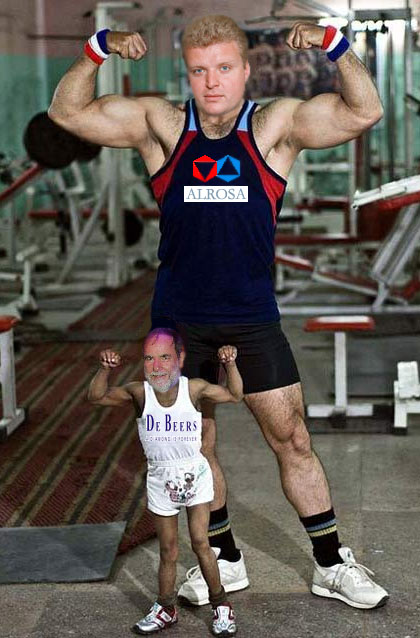
By John Helmer in Moscow
Russia’s dominant diamond miner, state-owned Alrosa, has grabbed the crown from De Beers as the world’s largest diamond producer – and most profitable one, too.
According to a press release, reporting what was said at the executive board meeting of Alrosa in Mirny, early this week, a draft annual report for last year was recommended for approval by the Supervisory Board, as Alrosa’s board of directors is known. Since the board has yet to meet and vote its approval, no report has been issued yet. However, the company release claims this report contains an aggregate diamond sales result for 2009 of $2,212.6 million. If this includes sales of polished, as well as rough, then it marks a decline of 5.3% on 2008. when Alrosa reports selling $157.6 million worth of polished, and $2,178.8 million of rough.
A large net profit figure was reported, but when the rouble total of Rb2,348.4 million is converted, it makes just $78.3 million; in 2008, the bottom line was Rb1,574 million, and so profit has jumped 33% during the crisis year, when roughly half of the company’s sales volume was purchased by the state stockpile agency, Gokhran. The company’s executive board has recommended that “due to the difficult economic situation of ALROSA resulting from the downturn of the global rough and polished markets, the Company’s considerable capital expenditure on underground mine construction, and a need to substantially reduce its debt obligations, the Executive Committee resolved to propose that the Supervisory Board recommend to the General Meeting of Shareholders that no dividends be paid for 2009.
The strike-out for De Beers, headed by Nicky Oppenheimer (left), is in an unprecedented disclosure by Alrosa of the carat figure for mine output of rough last year. Although the state secrecy resrictions for diamond reserves, exports, and sales were relaxed several years ago, Alrosa, headed by Fyodor Andreyev (right), generally does not publish production or sales volumes in carats, or an average sales price realized per carat. This year, however, is an exception to this rule. “In spite of the recession in its sector,” the company communique says, “ALROSA managed to preserve jobs and maintain its production levels, and produce in 2009, in the aggregate, 34 m carats of rough diamonds. This enabled the Company to rank first in the world in terms of physical volumes of diamond production.”
Anglo American Plc publishes diamond output data for De Beers in its annual reports, and De Beers issues carat breakdowns for production at each of its mines worldwide. These show that in 2007 De Beers peaked at almost 50 million carats per annum. In 2009, the total had fallen to just 24.6 million carats, three-quarters of which were mined in Botswana. In 2008, the De Beers total was 48.1 million carats. According to De Beers’s balance-sheet for 2009, sales revenues amounted to $3.8 billion, down 44% on 2008. The after-tax bottom line for 2009 was a loss of $31 million, compared to a profit of $224 million the year before.
Russian diamantaires acknowledged that publication of a total carat figure is unusual for Alrosa, but they caution against trying to use the number to gauge per carat prices realized by the company’s sales. Ararat Evoyan, head of the Russian Association of Diamond Manufacturers, told PolishedPrices.com: “they don’t sell everything they extract, and, on the contrary, they may sell what they had previously kept in the reserves. In order to count the median or average price, you want to know the whole cycle, and people outside the company have no idea. Alrosa has a high percentage of diamond extraction; they accept even the smallest sizes, and their assortment is very broad. But together with that, I have to admit that the quality of their stones is rather high. Both Alrosa and their clients are interested not to disclose the figures of their transactions. The commercial secret suits both.”
“Why is Alrosa concealing the prices of certain contracts?” another Moscow diamond source asked. “This is the usual thing about them. They are traditionally not too transparent. If they did disclose the prices, then their clients would be able to compare the costs of various transactions, and find out differences; they would complain and challenge the deals. Alrosa doesn’t want this. Actually, commercial secrecy is normal among all diamond companies. DeBeers isn’t much more transparent either”.











Leave a Reply